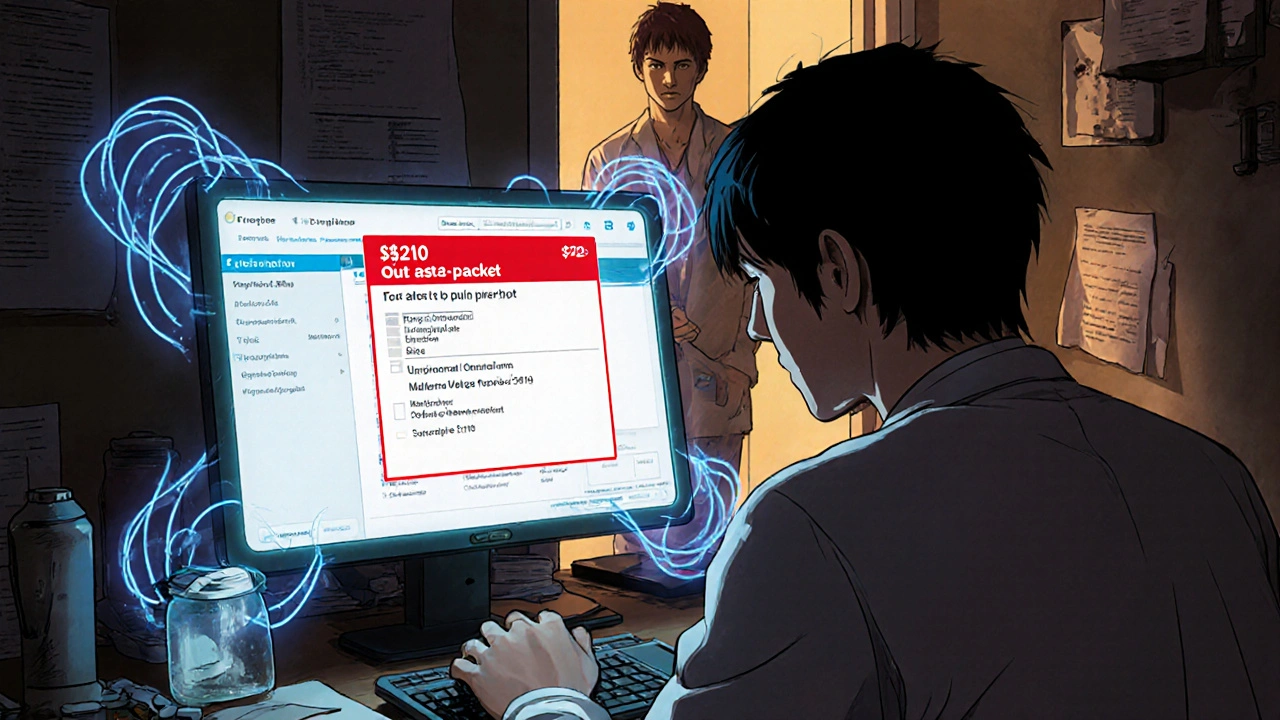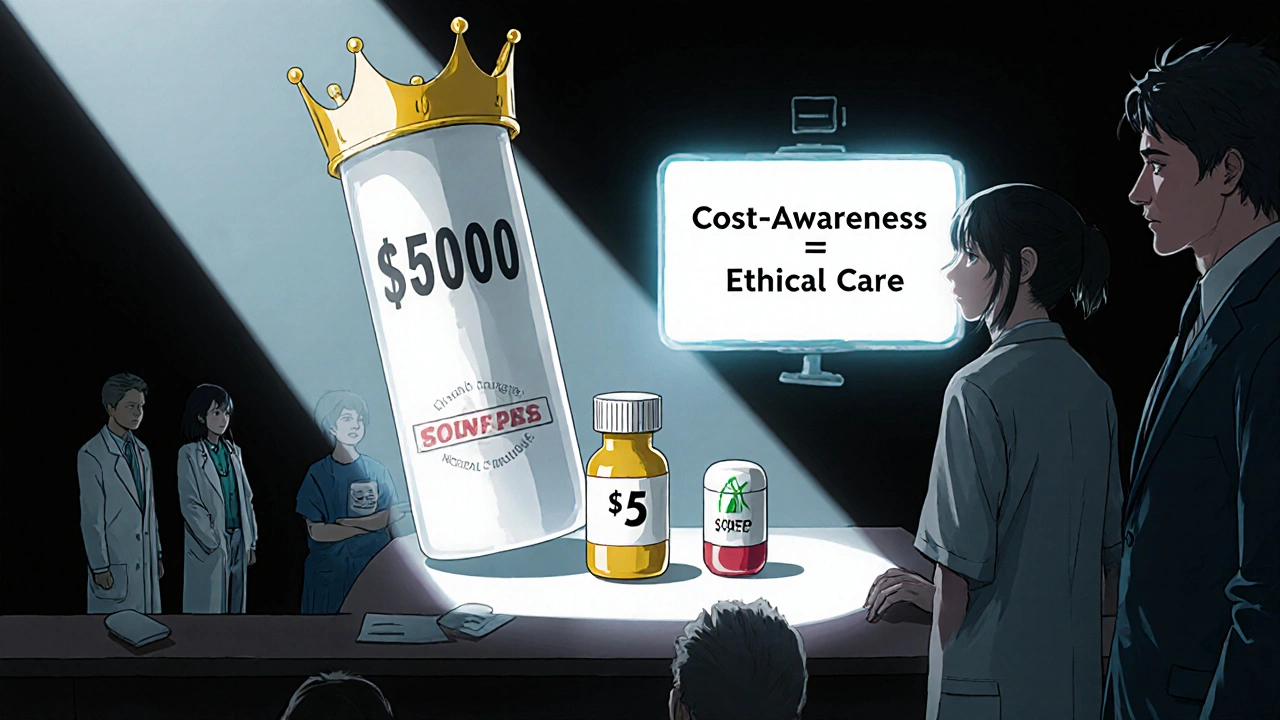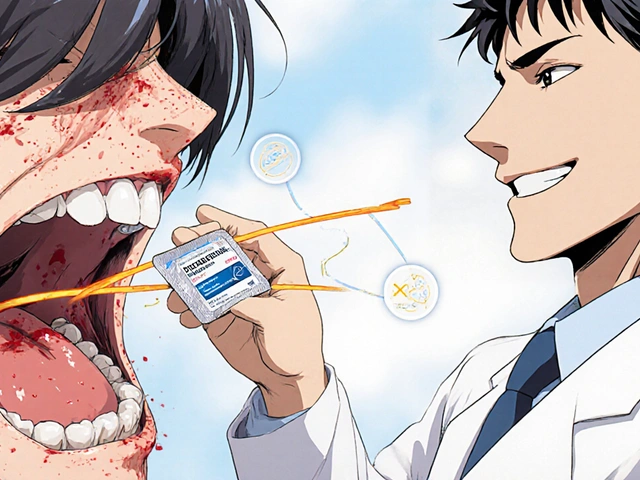
Imagine you’re a doctor, seeing a patient with high blood pressure. You write a prescription for a common medication-lisinopril. It’s a generic drug, widely used, safe. But you don’t know if it costs $4 or $40 at their local pharmacy. You assume it’s cheap. It is. But you also don’t know their insurance plan has a $100 deductible, so they’ll pay the full price out of pocket. And that $4 drug? They can’t afford it. So they skip doses. Or skip the visit entirely. This isn’t rare. It’s routine.
Doctors are guessing at drug prices-and it’s costing patients
Studies show clinicians consistently misjudge medication costs. In one major review, doctors overestimated the price of inexpensive drugs by 31% and underestimated expensive ones by 74%. That’s not a small mistake. It’s a systemic blind spot. A 2016 study of 254 medical students and doctors found that only 5.4% of generic drug prices were estimated within 25% of the actual cost. For brand-name drugs? Just 13.7%. And even then, most of those correct guesses were lucky, not informed.
Why does this matter? Because when doctors don’t know what a drug costs, they can’t make cost-conscious choices. A patient might be prescribed a $300 monthly injectable when a $15 tablet does the same job. The doctor isn’t being careless-they just don’t have the data. And in a system where 28% of adults skip doses because of cost, that gap isn’t just inconvenient. It’s dangerous.
Why don’t doctors know the prices?
It’s not because they’re uninterested. In fact, 92% of physicians in a 2007 survey said they wanted cost information at the point of care. But it’s not there. Drug pricing is a maze. The same pill can cost $15 at one pharmacy and $320 at another. Insurance networks change. Copays vary by plan. Manufacturer coupons aren’t always usable. And most electronic health records (EHRs) don’t show real-time patient-specific pricing.
Medical schools barely teach it. A 2021 study found 56% of U.S. medical schools have no formal curriculum on drug pricing. Residents learn by trial and error-checking websites, calling pharmacies, wasting minutes per prescription. One primary care doctor on Reddit said checking costs added 30 minutes to their day. That’s not sustainable.
What changes when cost info is built into the system?
When cost data is embedded directly into EHRs-when a pop-up says, “This drug costs $210 out-of-pocket. A similar alternative costs $12”-things shift. A 2021 JAMA Network Open study showed doctors with real-time cost alerts were significantly better at estimating prices. But more importantly, they changed their prescribing.
At UCHealth, after launching a real-time benefit tool (RTBT), one in eight primary care doctors switched a prescription after seeing a cost alert. When potential savings exceeded $20, that number jumped to one in six. In safety-net clinics, where patients are more likely to be underinsured, prescription changes rose by 22% compared to private practices. That’s not just efficiency. That’s equity.
These tools aren’t perfect. One resident on Reddit pointed out that EHR alerts often show insurer pricing, not the patient’s actual copay. That’s a flaw. But it’s fixable. The technology exists. The data is available. What’s missing is consistent implementation.

Who’s doing it right?
Some institutions have made cost awareness part of their culture. Mayo Clinic’s Drug Cost Resource Guide, updated quarterly since 2019, is rated 4.7 out of 5 by over 1,200 physicians. It’s simple: searchable, accurate, and integrated into their workflow. Contrast that with the generic Medicare Part D formulary reference, rated just 2.8 out of 5 by 850 users. One is a tool. The other is a footnote.
Harvard and UCHealth are now studying whether these tools reduce racial and ethnic disparities in medication access. Early data suggests they do. Patients in under-resourced clinics-who are more likely to face cost-related non-adherence-benefit the most from real-time pricing. That’s not a coincidence. It’s a design feature.
Why aren’t more hospitals using these tools?
Cost. Development. Integration. UCHealth spent 18 months and $2.3 million to build their system. Many smaller clinics can’t afford that. There’s also resistance. Some doctors fear alerts will slow them down. Others worry about being told what to prescribe. And there’s the myth that “doctors should focus on medicine, not money.” But that’s outdated. When a patient can’t afford their medicine, the medicine doesn’t work. That’s not economics-that’s clinical failure.
Only 37% of U.S. health systems have implemented real-time benefit tools as of late 2024. The rest are flying blind.

The policy shift changing everything
The 2022 Inflation Reduction Act gave Medicare the power to negotiate drug prices for the first time. It’s a landmark change. And it’s not just political. 80% of Americans, across party lines, support it. That’s rare. More importantly, it’s forcing manufacturers to be more transparent. CMS now requires drugmakers to report out-of-pocket cost estimates. That data will eventually flow into EHRs.
Meanwhile, the Institute for Clinical and Economic Review found that in 2023, the net prices of five major drugs increased-without any new clinical benefits. Humira’s price went up 4.7%. No new indication. No new data. Just more profit. When pricing is disconnected from value, clinicians need tools to push back. Cost awareness isn’t optional anymore. It’s part of ethical care.
What’s next?
The future isn’t just about knowing prices. It’s about understanding value. Is this $500 drug truly better than the $50 one? Are we prescribing based on science-or marketing? Tools are evolving to show not just cost, but cost-effectiveness. By 2027, 75% of U.S. health systems are projected to use advanced real-time benefit tools with value-based recommendations.
But progress depends on education. Medical schools must teach drug pricing. Residents need training. Clinicians need access. And patients need to be part of the conversation. When a doctor asks, “Can you afford this?”-it shouldn’t feel like an awkward question. It should be as routine as asking about allergies.
Doctors don’t need to become accountants. They need to know enough to ask the right question-and have the data to answer it. That’s not asking too much. It’s the bare minimum for good care.
Why don’t doctors know how much medications cost?
Most doctors don’t have access to real-time, patient-specific pricing data during appointments. Drug prices vary by pharmacy, insurance plan, and manufacturer coupons, making it nearly impossible to know the exact cost without spending minutes on a separate search. Medical schools rarely teach drug pricing, and EHRs often lack integrated cost tools, leaving clinicians to guess or rely on outdated formularies.
Do cost alerts in EHRs actually change prescribing?
Yes. Studies show that when real-time cost information is embedded in electronic health records, one in eight primary care physicians change a prescription-rising to one in six when savings exceed $20. In safety-net clinics, prescription changes increased by 22% compared to private practices, showing that cost alerts improve care for the most vulnerable patients.
Are generic drugs always cheaper than brand-name drugs?
Usually, but not always. While generics are typically far less expensive, insurance formularies and pharmacy benefit managers can sometimes make a brand-name drug cheaper for a specific patient due to coupons, rebates, or plan design. That’s why real-time, personalized pricing is essential-general assumptions often lead to wrong choices.
How accurate are clinicians at estimating drug prices?
Not very. A 2016 study found only 5.4% of generic drug prices and 13.7% of brand-name drug prices were estimated within 25% of the actual cost. Doctors frequently overestimate low-cost drugs and underestimate expensive ones, leading to poor prescribing decisions that can harm patient adherence.
Is this just a U.S. problem?
No, but it’s most severe in the U.S. due to its complex, fragmented pricing system. In countries with single-payer or regulated pricing, drug costs are more transparent and consistent. However, even in those systems, clinicians often lack access to patient-specific out-of-pocket costs, which affects adherence and decision-making.
What can patients do if their doctor doesn’t know the cost of their prescription?
Ask. Say, “Can you help me find a lower-cost option?” or “Is there a generic version?” Bring your insurance card or use apps like GoodRx to check prices at nearby pharmacies. Many doctors want to help-they just need the tools and the prompt. Your input can lead to better, more affordable care.




Sridhar Suvarna
November 17, 2025Doctors in India face the same problem but worse. We don't even have EHRs in most clinics. I once prescribed a medicine and the patient came back crying because it cost his entire monthly wage. I had no idea. No system tells you. You just hope you're right. This isn't just a US issue-it's a global failure of systems that treat patients like numbers.
Joseph Peel
November 17, 2025The data is clear and well-documented. The failure is institutional. Medical education ignores cost literacy because it's perceived as non-clinical. But when a patient skips insulin because they can't afford it, that’s a clinical failure. Real-time pricing tools aren’t optional-they’re essential clinical infrastructure. We’ve integrated EHRs for labs, vitals, and imaging. Why not cost?
Kelsey Robertson
November 18, 2025Oh, please. Let’s not pretend doctors are innocent victims here. They’re the ones who prescribe brand-name drugs because Big Pharma reps hand them free samples and lunch. And don’t get me started on the $300 ‘miracle’ drugs that are just rebranded generics! The problem isn’t lack of data-it’s lack of will. Doctors love their prestige. They don’t want to be seen as ‘cheap’-they want to be seen as ‘cutting-edge.’ And patients pay the price for that ego.
Joseph Townsend
November 19, 2025Bro. I’m a resident. I’ve spent 47 minutes in one shift just Googling prices, calling pharmacies, checking GoodRx, and then explaining to a patient why their $1200 pill isn’t the only option. I’m not lazy. I’m not ignorant. I’m just drowning in a system that treats cost like a dirty secret. And now they want me to be a pharmacist too? I didn’t go to med school to be a financial advisor. I went to save lives. But if the patient can’t afford the cure… what’s the point?
Kyle Swatt
November 19, 2025It's not just about price-it's about power. The system is designed to keep doctors in the dark so that pharmacies, insurers, and pharma companies control the narrative. When you don't know the cost, you can't challenge it. When you can't challenge it, you're complicit. This isn't negligence. It's structural violence. And the people who suffer? They're the ones who show up, pay cash, and still say 'thank you' because they're too scared to ask for help.
Deb McLachlin
November 19, 2025The integration of cost data into clinical workflows is not merely a technological upgrade-it represents a paradigm shift in the ethical obligations of medical practice. If a clinician's duty is to promote patient welfare, and if cost-related non-adherence directly undermines that duty, then the absence of cost transparency constitutes a breach of professional responsibility. The burden must not fall on the patient to negotiate affordability.
saurabh lamba
November 20, 2025lol doctors dont know prices? imagine that. next theyll tell us they dont know water is wet. just give me the pill and ill figure out the rest. why should they care? they get paid either way. its all just a business. we are the product.
Kiran Mandavkar
November 21, 2025Of course doctors don’t know prices. They’re too busy playing God with their white coats and diplomas. Real medicine isn’t about cheap pills-it’s about innovation, breakthroughs, prestige. If your patient can’t afford the $500 drug, maybe they shouldn’t be alive. Capitalism isn’t a bug-it’s the feature. Stop whining about cost and start producing better patients. Or better yet-stop being a burden on the system.
Eric Healy
November 22, 2025you know what the real problem is? patients think they deserve free medicine. if you cant afford it then dont take it. doctors arent accountants. theyre healers. stop making them guess prices. fix the system. not the doctors. theyre doing their best with broken tools
Shannon Hale
November 24, 2025THIS IS WHY WE’RE DYING AS A NATION. DOCTORS AREN’T JUST IGNORANT-THEY’RE COMPLICIT. THEY’RE PRESCRIBING $300 DRUGS WHILE PEOPLE SELL THEIR BLOOD PLASMA TO PAY FOR INSULIN. AND THEY’RE TOO EMBARRASSED TO ADMIT THEY DON’T KNOW WHAT’S GOING ON. IT’S NOT A SYSTEM FAILURE-IT’S A MORAL FAILURE. AND YOU KNOW WHO’S TO BLAME? THE DOCTORS WHO THINK THEY’RE ABOVE THE MONEY GAME. THEY’RE NOT HEROES. THEY’RE PART OF THE MACHINE.
Holli Yancey
November 25, 2025I’ve seen this happen. A woman with diabetes, working two jobs, skipped her meds for three months because she thought the $120 pill was covered. Her A1c hit 12. She ended up in the ER. The doctor felt terrible. But he didn’t know. He wasn’t given the tools. And now he’s afraid to prescribe anything. It’s not that they don’t care. It’s that they’ve been trained to ignore the question.
Gordon Mcdonough
November 26, 2025AMERICA ISN’T BROKEN-IT’S BEING WEAKENED BY LIBERALS WHO WANT FREE MEDS FOR EVERYONE. DOCTORS SHOULD PRESCRIBE WHAT WORKS NOT WHAT’S CHEAP. IF YOU CAN’T AFFORD IT THEN YOU SHOULD’VE SAVED MONEY OR GOTTEN A BETTER JOB. THIS ISN’T A MEDICAL ISSUE-IT’S A PERSONAL RESPONSIBILITY ISSUE. STOP BLAMING THE DOCTORS FOR YOUR BAD LIFE CHOICES.